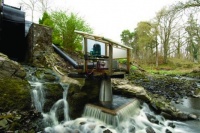Gordon Brown is doing it, the Tories are tweeting about it and, if the hype is to be believed, over the next few years we will all be investing massive amounts of money to lavish our homes with it.
Microgeneration, once a dream of hippy communities, is to become the latest trend in cutting carbon emissions. On 1 April, the government will launch its much-anticipated feed-in tariff, which will provide households with cash in return for generating energy from low-carbon domestic systems.
With the UK facing soaring energy bills, the Energy Saving Trust (EST) believes the tariff will be enough to convince most of the population to install what were once seen as exotic technologies, such as fuel cells, solar photovoltaics (PV) and ground-source heat pumps, in and around their homes.

Steven Harris, who recently joined the EST as head of low-carbon technologies, predicts that this could happen within the next few years. ’The poor old cottage industry of renewable energy will not know what’s hit it,’ he said. ’People could be forgiven for waiting to install these technologies up until this point, but once the tariff comes in, things could change rapidly.’
As someone who has built his own zero-carbon home, Harris is excited at the prospect of seeing low-carbon homes rolled out across the country. He believes the feed-in tariff will trigger a radical change in the UK landscape and enthusiastically describes his vision of a skyline packed with wind turbines and rooftops humming with solar PV.
Ten years ago, along with fellow designer Bill Dunstar, Harris attempted to make his ’hypothetical hope city’ a reality as part of a project known as BedZed. Today, a stroll in the quiet London suburb of Wallington will lead you to the carbon-neutral BedZed village, which was shortlisted for the Stirling Prize in 2003 and is currently the UK’s largest mixed-use sustainable community.
I’m really looking forward to the day soon when engineers will look quizzically at people who haven’t got solar panels and wind turbines and say: “How the hell can you afford not to have them?”
Steven Harris
’It’s amazing when you sit in meetings now; people are saying exactly the same stuff that was laughed at when we were starting BedZed,’ said Harris. ’Back then, things such as using reclaimed materials, sustainability assessments, local sourcing, having an ecological footprint… they were just not on the construction agenda, let alone the housing agenda.’
Attitudes towards low-carbon solutions have changed dramatically in the past few years. Alongside the tariff, the government has set targets to produce 40 per cent of the UK’s electricity from low-carbon sources by 2020. During this time, it estimates that 1.5 million households will be able to produce their own clean energy, while seven million homes will have whole-house makeovers.
Yet, despite the fanfare surrounding microgeneration, there remain significant barriers to making it a widespread reality. The biggest of these appears to be public concerns over its effectiveness. With B&Q quietly shelving its micro wind turbines last year owing to their poor generation performance, householders could be forgiven for not investing in similar products that do not provide an adequate return.

Harris claims that what is needed is solid black-and-white data on the performance of microgeneration systems. ’We’re conducting large-scale domestic field trials of the whole spectrum of microgeneration devices and we’ve already come up with some surprising results,’ he said.
From these trials, one technology Harris keeps coming back to is solar PV, which could give households significant returns on their investments. Installing one kilowatt of PV for an upfront cost of £4,000-£6,000 is estimated to create an annual return of £500.

’Solar technology has really moved forward,’ he said. ’In China, it’s illegal not to put thermal solar on your roof, but they have the advantage of a totalitarian state. The fact that they have to manufacture panels for billions of people has really driven down the cost of solar. I know when we first started BedZed, the payback on a panel was around 75 years; now it’s about 12.’
Wind turbines may have a slower uptake. The fact that wind speeds are variable and difficult to predict could put off investors in all but the windiest areas of the UK. Prediction tools for site identification are still being developed and determining the accurate data of energy generation is a difficult task.
However, in areas that experience strong winds, Harris believes the technology could overtake other forms of microgeneration. ’Our field trials in wind showed that the type of turbine you have really doesn’t make any difference,’ he said. ’If the location is good, it’ll be producing just as much energy.’
Location seems to be key for the future of energy production. Like wind and solar, Harris suggests technologies such as micro hydro and ground-source heat pumps will perform if they are in the right location. He believes it won’t be long before households trade in a similar way to city investors.
’In the future, your house will no longer be a passive consumer, but an active generator and trader, buying and selling energy, and making a big profit at the end of the end of the year,’ he said. ’I’m really looking forward to the day soon when engineers will look quizzically at people who haven’t got solar panels and wind turbines and say: “How the hell can you afford not to have them?”
Q&A - taking a leap of faith for microgeneration
How has the housing world changed since you began BedZed?
Housing was just a really low-cost-budget, crappy world. It wasn’t even the B team working there; it was the D or the C team. Not where people had an ambition to be doing stuff. Only eight per cent of houses built ever saw an architect; they were just designed by a volume house builder. They were paid for product, not thinking, and then to be there from a thinking background was seen as very strange – this has changed a lot now.
Will financial incentives really be the key to investing in energy efficiency?
Definitely. I’ve sat at Lehman Brothers meetings, a few years ago now, and they were all interested in getting involved from a hard financial point of view. I also know households who have invested in microgeneration purely because its better than investing in a building society. You get a better rate of return.
Do you think the public are put off by the complicated nature of microgeneration?
I think it has a bad reputation for being too complicated. I used to give a lecture called ’Zero Carbon is Easy’ – because it is. I built a zero-carbon house, by myself, with my own hands. It’s the money that’s the hard bit. It’s the financial innovation that is the key to it and understanding that is critical.
What would you say to people who would rather wait for the technology to improve than invest now?
I’d say you’ve got to know when to leap… It’s just like buying a laptop. You kind of know that next year it’ll be half the cost and twice as fast. But you still need a laptop so you’ve got to do it. The feed-in tariff will make it cost effective. Now you’ll be able to sit with a straight face in front of the bank manager and they’d completely agree with the concept.
What’s the future for micro hydro?
Well you know the whole country used to have water mills. Areas such as where I live, in the Brecon Beacons, have been called the perfect landscape for micro hydro – steep-sided valleys with flat plateaux. I probably wouldn’t be too wrong in saying every village and town in the Brecon Beacons could be completely energy self sufficient off hydro schemes. But it’s really about location. In rural areas, I can see it being used a lot.
If there is a massive uptake of microgeneration devices in the next few years, will the industry be able to cope?
This technology used to very much be ’hippies-in-sheds’ stuff. The industry is growing but I don’t think we have the supply chain in place at the moment to cope with the government’s targets. The uptake really does depend on a lot of things, but if it captures people’s imaginations, the phones could go red hot with people wanting to get into it, and that will create a massive opportunity for UK manufacturers.
Biography

Education
- Bsc (hons) Diploma in Architecture
- The Bartlett School, University College London
Career
- 1990 -1995 Exhibition technician at The Architecture Foundation
- 1994 - 2000 Joined Michael Hopkins and Partners as an architect
- 2002-2005 Senior Lecturer In Environment and Energy, University of East London
- 2000-2009 Co-founder and technical director at ZEDfactory. Spent time in Namyangju Korea building a zero carbon building code and city energy strategy.
- 2009 Appointed head of Low Carbon Technology at the Energy Saving Trust





April 1886: the Brunkebergs tunnel
First ever example of a ground source heat pump?